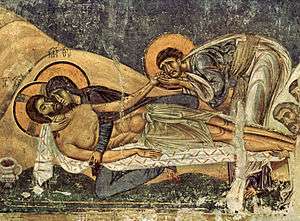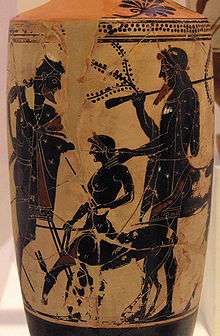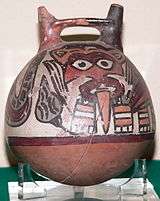History of graphic design
Graphics (from Greek γραφικός, graphikos) are the production of visual statements on some surface, such as a wall, canvas, pottery, computer screen, paper, stone or landscape. It includes everything that relates to creation of signs, charts, logos, graphs, drawings, line art, symbols, geometric designs and so on. Graphic design is the art or profession of combining text, pictures, and ideas in advertisements, publication, or website. At its widest definition, it therefore includes the whole history of art, although painting and other aspects of the subject are more usually treated as art history.[1]
History
Hundreds of graphic designs of animals by the primitive people in the Chauvet Cave, in the south of France, which were drawn earlier than 30,000 BC,[2] as well as similar designs in the Lascaux cave of France that were drawn earlier than 14,000 BC,[3] or the designs of the primitive hunters in the Bhimbetka rock shelters in India that were drawn earlier than 7,000 BC,[4] and the Aboriginal Rock Art, in the Kakadu National Park of Australia,[5] and many other rock or cave paintings in other parts of the world show that graphics have a very long history which is shared among humanity. This history together with the history of writing which was emerged in 3000-4000 BC are at the foundation of the Graphic Art.
Rock and cave art
-

Drawing of horses in the Chauvet cave.
-

Drawing of a horse in the Lascaux cave.
-
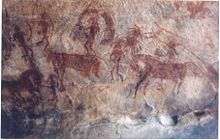
A rock drawing in Bhimbetka India.
-

Aboriginal Rock Art, Ubirr Art Site, Kakadu National Park, Australia
Writing
-

The Lantingji Xu, Preface to the Poems Composed at the Orchid Pavilion is the most famous work of Chinese calligrapher Wang Xizhi, created in year 353.[1]
-

Scribe's exercise tablet with hieratic text on wood, related to Dynasty XVIII, reign of Amenhotep I, c. 1514-1493 BC. Text is an excerpt from The Instructions of Amenemhat II (Dynasty XII), and reads: "Be on your guard against all who are subordinate to you ... Trust no brother, know no friend, make no intimates."
-

A Chinese traditional title epilogue written by Wen Zhengming in Ni Zan's portrait by Qiu Ying.(1470–1559)
-
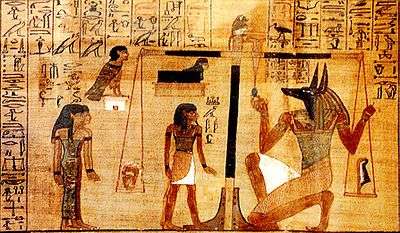
The Papyrus of Ani is a version of the Book of the Dead for the Scribe Ani. This vignette (small scene that illustrates the text) is Chapter for not letting Ani's heart create opposition against him in the God's Domain.[2]
- ^ "This calligraphy describes a gathering of 42 poets including Xie An and Sun Chuo at the Orchid Pavilion near Shaoxing, Zhejiang, during the Spring Purification Festival to compose poems and enjoy the wine. The poets had agreed to participate in a drinking contest: wine cups were floated down a small winding creek as the men sat along its banks; whenever a cup stopped, the man closest to the cup was required to drink it and write a poem. In the end, twenty-six of the participants composed thirty-seven poems". Richard Kurt Kraus, Brushes with Power (Berkeley: University of California Press, 1991), 27.
- ^ See : R.O. Faulkner, The Ancient Egyptian Book of the Dead (revised ed C. A. R. Andrews), The British Museum Press, 1985, London. R.B. Parkinson and S. Quirke, Papyrus, Egyptian Bookshelf, The British Museum Press, London, 1995. S. Quirke and A.J. Spencer
Use in books
Many books in the classical world were illustrated, although only a handful of original examples survive. Medieval religious illuminated manuscripts have used graphics extensively. Among these books are the Gospel books of Insular art, created in the monasteries of the British Isles The graphics in these books are influenced by the Animal style of the "barbarian" peoples of Northern Europe, with much use of interlace and geometric decoration.
-
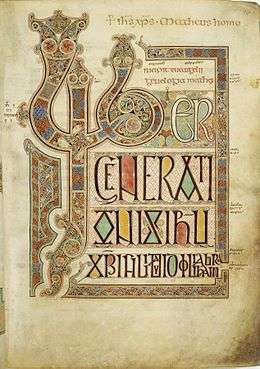
A page from Lindisfarne Gospels, c. 710
-

The Ada Gospels are one of a group of manuscripts, known to modern scholars as the Ada School. Its illuminations include an elaborate initial page for the Gospel of Matthew and portraits of Matthew, Mark and Luke. Late 8th century
-

A graphic decoration in the Book of Kells, c. 800
-
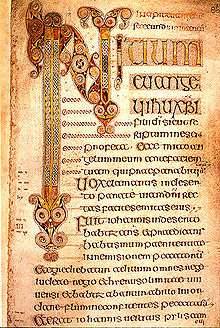
Opening page of Book of Durrow, 7th century
The Qur'an
In Islamic countries graphic designs were used to decorate their holy book, the Qur'an. Muslim scribes used black ink and golden paper to write utilizing an angled alphabet, called Kuffi. Such writings appeared in the 8th century, and reached their apex in the 10th century. Later on decoration of margin, page and other graphic techniques were added in order to beautify the book. In the 12th century, the Naskh alphabet was invented, which instead of angled lines used curves. Other styles such as Mohaghegh, Reyhan, Sols, Reghaa, and Toghii was added later on[6]
-
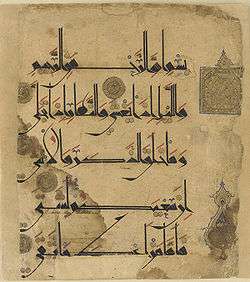
A page from a Persian Quran in the 11th century.
-
Graphic art in an Egyptian Quran of the 9th or 10th century.
-

An Iranian Quran of the 15th century found in Uzbekistan.
-

A Quran with Kuffi Alphabeth of the 12th century.
Calligraphy
-

Many believe that calligraphy adds a mystical dimension to a writing. Such mysticism appears to be consistent with the feeling that a religious text tries to convey. This is why to create a spiritual feeling many religious texts use calligraphy.
-
Handscroll%2C_ink_and_colors_on_paper%2C_28.4_x_93.2_cm_National_Palace_Museum%2C_Taipei.jpg)
Art of calligraphy in China goes back to 2000 BC. Chinese calligraphy was used to communicate the philosophical ideas of Confucius and Hundred Schools of Thought (諸子百家; zhūzǐ bǎijiā")[1]
-

Calligraphy entered Japan in the 3rd century BC from China during its states wars. Japanese used calligraphy to write their haikus on decorative banners.
- ^ "Calligrpahie" Larousse (French)
Maps
-
_from_Chonha_Chido_(Map_of_the_World)._Page_2_Hand-copied_manuscript_map_Korea_mid-eighteenth_century.jpg)
This is Page 2 of a hand-copied manuscript map from Korea, Chonhado (World Map) from Chonha Chido (Map of the World), mid-18th century.
-
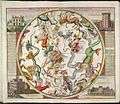
This is page 2 and 3 of a hand-colored engraving of Reiner Ottens' Atlas maior cvm generales omnivm. Amsterdam 1729. The constellations on this chart are elaborately represented by figures from classical antiquity. In the corners of the chart are illustrations of four European observatories, including that of the noted 16th-century astronomer Tycho Brahe (1546-1601).
Playing cards
It is believed that playing cards were invented in China.[7] Chinese playing cards, as we understand the term today, date from at least 1294, when Yen Sengzhu and Zheng Pig-Dog were apparently caught gambling in Enzhou (in modern Shandong Province).[8] Cards entered Europe from the Islamic empire.[9] The earliest authentic references to playing-cards in Europe date from 1377.[10] Europe changed the Islamic symbols such as scimitars and cups into graphical representations of kings, Queens, knights and jesters. Different European countries adopted different suits system, for instance Italian, Spanish, German and some other countries deck of cards, even today, do not have queens.[11][12][13] During the 15th century, Germans introduced wooden blocks printing technique to produce playing cards. They could quickly export these cards throughout Europe because of their lower costs. The substitution of wood blocking and hand coloring with copper plate engraving during the 16th century was the next significant innovation in the manufacturing of playing cards. The mass printing of playing cards was revolutionized with the introduction of color lithography in the early 19th century.[14]
-

These are Card designs from the Mamluk Sultanate of Egypt. c. 1500. According to a passage in Ibn Taghri Birdi's HISTORY OF EGYPT, 1382-1469 A.D., the future sultan al-Malik al-Mu'ayyad won a large sum of money in a game of cards.[1] In the Islamic empire playing cards the suits were coins, cups, swords, and polo sticks.
-

Germans introduced wooden blocks printing
- ^ Yusef. William Popper, translator of Abu L-Mahasin ibn Taghri Birdi, HISTORY OF EGYPT, 1382-1469 A.D., University of California Press (1954), ASIN B000KJB70S
German suits
-
The extinct Ancbacher Nuremberg design (by F.X Schmid).
-
German single-headed Schwerterkarte playing cards, (by SA)
-
File:A northern Germany suit design of playing cards (by ASS).
-

German art nouveau playing cards printed in Attenburg, 1900.
Selected European suits
-

Traditional English playing cards, James Hardy, London 1827 and Germany C 1810[1]
-

Latvian playing cards designed by Arturs Dubrus in 1942.
-

Russian playing cards with Mayan Image, 1960s.
- ^ University of Waterloo Playing Cards: British
- ^ University of Waterloo Playing Cards: France
- ^ University of Waterloo Playing Cards: Germany (Spielkarten)
Byzantine art
The Byzantine Empire began when the Emperor Constantine moved the headquarters of the Roman Empire from Rome to Byzantium (present day Istanbul) which he renamed Constantinople. The Byzantine empire, although marked by periodic revivals of a classical aesthetic of the art of the Roman empire and ancient Greek, was above all marked by the development of a new aesthetic which Josef Strzygowski viewed it as a product of "oriental" influences.[15] The subject matter of Byzantine art was primarily religious and imperial. Byzantine art is more spiritual in content (figures presented as representations of the soul rather than the body) and yet more "worldly" in form with a show of gold, silver, precious and semi-precious stones.
-
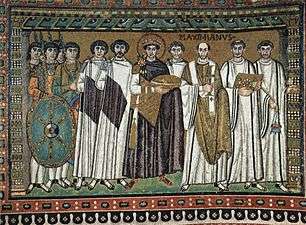
Mosaic from Basilica of San Vitale in Ravenna, Italy, showing the Emperor Justinian and Bishop Maximian of Ravenna surrounded by clerics and soldiers. Here the graphic statement conveys the unification of the church and state.
-

Mosaic from the church of Hagios Demetrios in Thessaloniki, late 7th or early 8th century, showing St. Demetrios with donors. Artists used highly decorative, symbolic, and flattened graphical representations of Christian saints by setting small pieces of colored glass into the mortar of the church walls at different angles to catch the light. An heavenly atmosphere was created by using gold backgrounds together with haloed figures.
-

Two-sided icon with the Virgin Psychosostria (saver of souls) and the Annunciation. Byzantine (Constantinople), early 14th century. One of the most important genres of Byzantine graphic art was the icon, an stylized image of Christ, the Virgin, or a saint, used as an object of veneration in Orthodox churches and private homes alike.
Miniatures
-

In this miniature painting of king Henry I of England, from illuminated Chronicle of Matthew, Paris, (1236-1259), now in British Library,[1] many of the principles of the modern graphic design is followed. The 13th-century paintings with their bright and golden colors were influenced by the Byzantine art. After the crusaders' sack of Constantinople in 1204, many works of Byzantine art entered and influenced Western Europe.[2]
-

In this Iranian miniature, based on the tragedy of two lovers Laily and Majnoon by Nizami Ganjavi (second half of the 16th century), the broken perspective, together with utilization of text and design is used to communicate the message of the story.[3]
-
.jpg)
In this 16th-century miniature of Reza Abbasi the simplicity of composition and the harmony of color scheme are consistent with the minimalist principles of the modern graphic design.
-
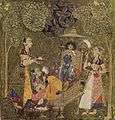
The Persian graphic designers of Indian court Mir Sid Ali, and Abdol-Sanad Khan in the second half of the 16th century influenced the Indian miniature paintings. In this 18th-century miniature the impact of this influence can be detected.[4]
- ^ MS Royal 14 CVII, f.8v
- ^ Bomford, David, et al. Italian Painting before 1400. Exhibition catalogue. London: National Gallery Publications, 1989. Borsook, Eve. The Mural Painters of Tuscany: From Cimabue to Andrea del Sarto. 2d ed. Oxford: Clarendon Press, 1980. See also: # A Thirteenth-Century Byzantine Miniature in the Vatican Library # Robert S. Nelson # Gesta, Vol. 20, No. 1, Essays in Honor of Harry Bober (1981), pp. 213-222, International Center of Medieval Art
- ^ Persian Miniature Painting and Its Influence on the Art of Turkey and India, by Norah M. Titley، Univ of Texas Pr; 1st University of Texas Press ed edition (March 1984), ISBN 978-0-292-76484-2. See also: Arberry, A. J., Minovi, M., and Blochet, E., The Chester Beatty Library: A Catalogue of the Persian Manuscripts and Miniatures, vols., (Dublin: 1959) Binyon, Laurence, Wilkinson, J. V. S., and Gray, Basil, Persian Miniature Painting (including a critical and descriptive catalogue of the miniatures exhibited at Burlington House, January–March 1931), (New York: 1933). Blochet, Edgar, Catalogue des Manuscrits Persans dans la Bibliothèque Nationale, t. 3, (Paris 1928). See also his «Les Écoles de Peinture en Perse,» in Revue Archéologique, t. 6 (Dec 1995), pp. 121-48. Bronstein, Léo, «Space Forms in Persian Miniature Composition,» in Bulletin of the American Institute for Persian Art and Archaeology, vol. IV (1935), pp. 111-9. Canby, Sheila, Persian Painting, (New York: 1993). Coomaraswamy, Ananda K., Les Miniatures Orientales de la Collection Goloubew au Museum of Fine Arts de Boston, (Paris: 1929). Gray, Basil, Persian Painting from Miniatures of the XII-XVI Centuries, (Bern: 1947). Kühnel, Ernst, Persische Miniaturmalerei (13. Jahrhundert bis 17. Jahrhundert), (Berlin: 1959). Marteau, Georges, and Vever, Henri, Miniatures Persanes (Exposées au Musée des Arts Décoratifs, Juin-Octobre 1921), (Paris: 1913). Holter, Kurt, Persische Miniaturen, (Vienna: 1921).
- ^ Beach, Milo Cleveland, "Mughal and Rajput Painting" (The New Cambridge History of India): Cambridge, 1992. Cooper, David (ed), A Companion to Aesthetics (Blackwell Companions to Philosophy): Massachusetts, 1997. Daljeet, Dr. Mughal and Deccani Paintings (From the Collection of the National Museum): New Delhi, 1999. Losty, Jeremiah P. The Art of the Book in India: London, 1982. Mansingh, Surjit, Historical Dictionary of India: New Delhi, 2000. Okada, Amina, Imperial Mughal Painters: Paris. Randhawa, M.S. Paintings of the Babur Nama: New Delhi, 1983. Sen, Geeti, Paintings from the Akbar Nama: Varanasi, 1984. Verma, Som Prakash (ed). Flora and Fauna in Mughal Art: Mumbai, 1999. Welch, Stuart Cary, Imperial Mughal Painting: New York, 1978. Ziad, Zeenut The Magnificent Mughals: Karachi, 2002
Asian paintings: China, Japan, and Vietnam
-
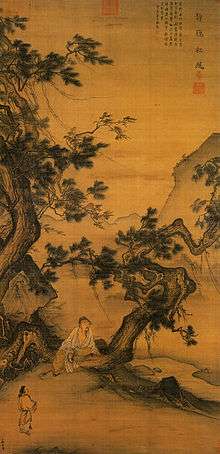
The study of graphic design technique and the drawing style in this early-13th-century work of the Chinese painter Ma Lin is revealing. The artist conveys his message by breaking the perspective rules of proportionality. For example, the person in front of the picture is smaller than the person in the back. This is intended to show that the person in the back is of greater importance (perhaps he is a sage or a spiritual teacher), The composition of trees in the form of an X, which is centered on the main character, adds to his significance. These techniques are being used in the modern graphic design.[1]
-
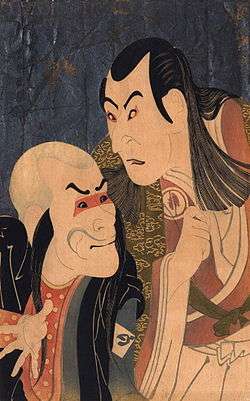
This wood print of the 18th century, a graphic work by the Japanese artist Toshusai Sharaku, is a two-dimensional compositional design. Japanese woodblock printing and painting style have influenced the design of modern posters through the works of artists like Toulouse-Lautrec.[2]
-
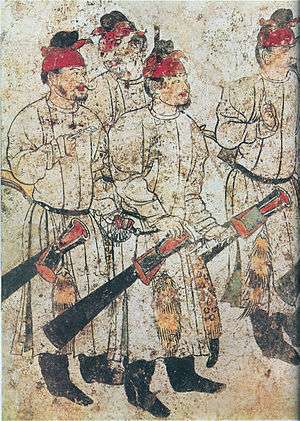
This Chinese wall painting of figures in a cortege, in the tomb of Li Xian, during Tang Dynasty in the 7th century uses a simplified composition, together with a particular use of a color scheme in order to create an intended impact. The artist uses two parallel lines created by the composition of soldiers' black boots and red hats and visually connects them by the linear composition of their rifles.[3]
-

This Vietnamese woodprint of the village of Dong Ho Painting creates a specific aesthetic impact that can be attributed to its graphic design
- ^ Three Thousand Years of Chinese Painting, By Richard Barnhart, Yale University Press; New edition (2 August 2002), ISBN 978-0-300-09447-3. The British Museum Book of Chinese Art, by Anne Farrer, British Museum Press; Rev Ed edition (October 2007), ISBN 978-0-7141-2446-9
- ^ Muneshige Narazaki, Sharaku: The Enigmatic Ukiyo-e Master (Kodansha, Tokyo, 1983), Harold G. Henderson, Louis V. Ledoux, Sharaku's Japanese Theatre Prints: An Illustrated Guide to his Complete Work (Dover Publications, New York, 1984), For influences on Toulouse-Lautrec see: Toulouse-Lautrec (World of Art), by Bernard Denvir, Thames & Hudson (May 1991), ISBN 978-0-500-20250-0, J. Adhemar, ed., Henri de Toulouse-Lautrec: His Complete Lithographs and Drawings, trans. by M. Alexandre (1965); G. Adriani, Toulouse-Lautrec (1987); D. Cooper, Toulouse-Lautrec (1983); B. Denvir, Toulouse-Lautrec (1991); E. Feinblatt B. and Davis, Toulouse-Lautrec and His Contemporaries (1986); J. Frey, Biography of Toulouse-Lautrec (1993); P. Gimferrer, Toulouse-Lautrec (1990); E. Lucie-Smith, Toulouse-Lautrec (1977; repr. 1994); G. Mack, Toulouse-Lautrec: A Biography (1990); Henri Perruchot, Toulouse-Lautrec, trans. by H. Hare (1961); R. Thomson, et al., Toulouse-Lautrec (1991); W. Wittrock, Toulouse-Lautrec: The Complete Prints (1985).
- ^ Art in China (Oxford History of Art), by Craig Clunas, Oxford University Press (10 April 1997), ISBN 978-0-19-284244-2
Pottery
From ancient times graphic design has been used for decoration of pottery and ceramics
-
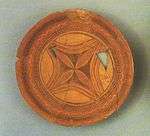
In the period 6500–5500 BC, the farming society of Halaf in northern Mesopotamia and Syria produced pottery that is among the finest in the Near East. The Halaf potters used different sources of clay from their neighbors and created interesting pottery.[1]
- ^ Campbell, Stuart. "The Halaf Period in Iraq: Old Sites and New." Biblical Archaeologist 55 (1992), pp. 182–87. Hijjara, Ismail. The Halaf Period in Northern Mesopotamia. London: Nabu Publications, 1997
Indigenous graphic art of the Americas
-

Art and religion are integral to all Native American indigenous peoples that come from many cultural groups and more than 500 tribal nations. They create designs that have been described as bold and imaginative graphic designs in both ceremonial and utilitarian objects. Iris & B. Gerald Cantor Center for Visual Arts[1]
-
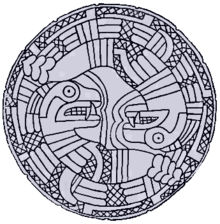
Notched stone palette from Mississippi region, with incised rattlesnakes.[3]
-
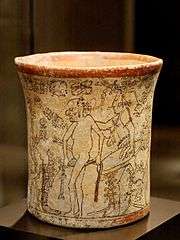
A Maya vase of the codex style, representing a lord of the underworld stripped of his clothes and headgear by the young Maize divinity, assisted by a midget and a hunchback. Terracotta, northern Petén (Guatemala), 7th-10th century.<ref>Coe, Michael, (1999) The Maya (6th ed.), Thames and Hudson: New York. Miller, Mary Ellen (1999) Maya Art and Architecture, Thames and Hudson: New York. Reents-Budet, Dorie, et al. (1994) Painting the Maya Universe: Royal Ceramics of the Classic Period, Duke University Press: Durham, NC and London.
- ^ Iris & B. Gerald Cantor Center for Visual Arts, Stanford University, California, USA
- ^ Allen, Catherine J., The Nasca Creatures: Some Problems of Iconography. Anthropology, 1981, Stony Brook: Department of Anthropology, State University of New York-Stony Brook. Carmichael, Patrick, Interpreting Nasca Iconography. in Ancient Images, Ancient Thought: The Archaeology of Ideology, 1992, Proceedings of the 23rd Annual Chacmool Conference, University of Calgary. Calgary: Department of Archaeology, University of Calgary.
- ^ FREDERICK WEBB HODGE, EDITOR, NOTCHED PLATE OF STONE FROM MISSISSIPPI, WITH ARTISTIC ENGRAVING OF FEATHERED RATTLESNAKES. 1907
Mayan and Aztec art
-
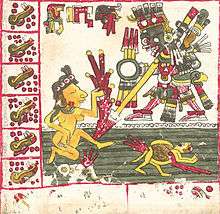
The Codex Borgia, now in the Apostolic Library of the Vatican, is one of the few surviving graphic art manuscripts of Aztecs. It is believed that it is from the central Mexican highlands near Puebla. This is an area which was under Aztec rule at the time of the Spanish conquest of Mexico.[1]
-
The Codex Borbonicus is a codex written by Aztec priests shortly before or after the Spanish conquest of Mexico. Like all pre-Columbian codices, it was originally entirely pictorial in nature, although some Spanish descriptions were later added.<ref>A photocopy of the original page 13 of the Codex Borbonicus, showing the 13th trecena of the Aztec sacred calendar (tonalpohualli). This 13th trecena was under the auspices of the goddess Tlazolteotl, who is portrayed wearing a flayed skin, giving birth to Cinteotl. The 13 day-signs of this trecena, starting with 1 Earthquake, 2 Flint/Knife, 3 Rain, 4 Flower, etc., are shown on the bottom row and, starting with 8 Lizard, 9 Snake, 10 Death, etc., in the column going up along the right side.
-
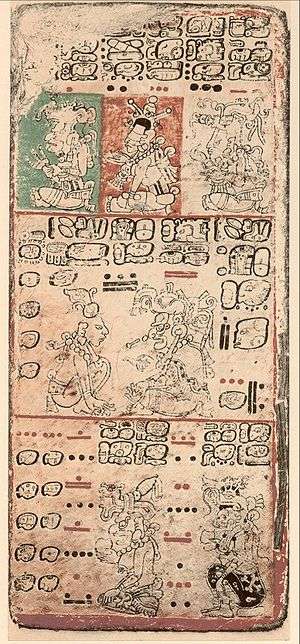
The Dresden Codex is an ancient Mayan book of the 11th or 12th century of the Yucatecan Maya. It is a highly important work of art. Many sections are ritualistic (including so-called 'almanacs'), others are of an astrological nature (eclipses, the Venus cycles). It was probably written just before the Spanish conquest.<ref>There were many such books in existence at the time of the Spanish conquest of Yucatán in the 16th century, but they were destroyed in bulk by the Conquistadors and priests soon after. In particular, all those in Yucatán were ordered destroyed by Bishop Diego de Landa in July 1562. Such codices were primary written records of Maya civilization, together with the many inscriptions on stone monuments and stelae which survive to the present day.
-

The Maya civilization is noted for its art, architecture, and mathematical and astronomical systems. At San Bartolo, located in the Department of Petén in northern Guatemala, murals dating from 100 CE depict the myth of the Maya maize god; the colours are subtle and muted, the style, although very early, is already fully developed. The murals depicts the Maya creation Myth as described in the Popol Vuh.[2]
- ^ Gisele Diaz, Alan Rodgers, The Codex Borgia: A Full-Color Restoration of the Ancient Mexican Manuscript, Dover Publications (June 22, 1993), ISBN 978-0-486-27569-7
- ^ Robert J. Sharer and Loa P. Traxler, The Ancient Maya, Stanford University Press, 2006, ISBN 978-0-8047-4817-9, Page 728
African art
-
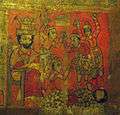
This detail from an Ethiopian painting with its line drawing, and coloring scheme anticipates many of the techniques used in modern posters. (end of the 17th century).[1]
-
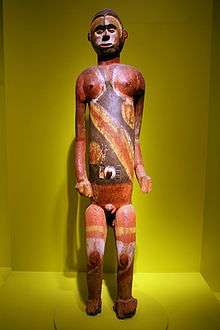
The use of graphic design with its broad and bold application of color that reinforces the strength of the carving is a feature of African art which has been described by some researchers as striking. Among the Igbo, such figures are sculpted by men and painted by women.[2]
-
.jpg)
Handbuilt pottery made by women, including those from the Kabyle, an older, probably indigenous tradition, dates back 2000 years before the birth of Christ. The vessel depicted here originates from earlier prototypes. To this day, Kabyle women coil and decorate pottery with painted geometric designs for their own household use and for sale.[3]
-
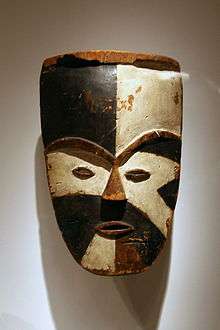
The disconnect between the divisions of the painted surface of this mask and the underlying carved form is an aspect of African art that has been described as striking and first entranced Western audiences.[4] This is a mask created by Tsogo peoples of Ogowe River region in Gabon. (Late 19th to early 20th century).[5]
- ^ The painting is from the northern wall of the Church of Abbas Antonios, Gondar, Ethiopia and now is in Musée des Arts Premiers (Musée du quai Branly), Paris; N° inventaire: 71.1931.74.3593
- ^ This male figure probably represented a community's founding ancestor or a warrior and was one of a large number of monumental figures kept in the men's meetinghouse to guard the private areas from intrusion. It likely was part of a group that included the founding ancestor's wife and other members of the village, such as warriors and hunters. This is one of only two published terracotta Oshugbo figures; others are copper alloy. (National Museum of African Art)
- ^ The inhabitants of the mountainous Kabyle region along the Mediterranean coast in northeastern Algeria were superb artists noted for their jewelry making, textiles, mats, basketry, pottery and house mural decoration. In North Africa, wheel-thrown pottery made by men dates from the 7th century BC when the Phoenicians introduced the potter's wheel to the Algerian coast. Kabyle women handbuild vessels of various sizes and shapes for holding water, milk, oil, cooking and eating food, and oil lamps. (See the introduction in National Museum of African Art, Washington DC)
- ^ Susan Mullin Vogel, Baule: African Art, Western Eyes, Yale University Press (October 20, 1997), ISBN 978-0-300-07317-1, Peter Stepan, Prestel Publishing (October 31, 2005), ISBN 978-3-7913-3228-4
- ^ The Western lack of awareness of context was such that when this mask was exhibited in the 1950s in France, it was identified as coming from another part of Africa. Later research attributed this mask to the Tsogo peoples as part of wider regional tradition of divided color faces. An American writer visiting a Tsogo village in the 1860s was most impressed by the decorative work on the doors of many of the houses and commented on their complicated patterns in red, white and black. (National Museum of African Art)
Mondrian's minimalism revolution
Less is more. That is the basic premise of a minimalist color poster design. The Dutch painter Piet Mondrian in the years 1920-21 courageously introduced the style of minimalism in painting. His simple geometric compositions, together with the use of only three basic colors, blue, yellow, and red, in combination with black and white created a new venue for the graphic designers. He demonstrated that with simple relocation of these colors, and experiment with the proportionality of various square surfaces one can achieve extremely different ambiances and various feelings. For the graphic designers who intend to convey a message with a minimum interference from the extraneous elements his experiment in minimalism was a valuable gift.[16]
Communication
-

Many medical organizations use the rod of Asclepius as their logo, since it symbolizes the healing arts. This kind of sign is called pictogram[1][2] The main advantage of a pictogram is that one does not need to be able to read or to understand a particular language in order to be able to understand the information it conveys.[3]
-

This is the Swedish traffic sign for no parking zone . The red circle with a diagonal line crossing it coveys the idea of "Not Allowed", and is called an ideogram.
- ^ Larousse
- ^ لاروس
- ^ According to Greek mythology, Asclepius was said to have learned the art of healing from the centaur Chiron. He is customarily represented as a surgeon on the ship Argo. Asclepius was so skilled in the medical arts that he was reputed to have brought patients back from the dead. For this, he was punished and placed in the heavens as the constellation Ophiuchus (meaning "serpent-bearer").
A rebus (Latin: "by things") is a kind of word puzzle which uses pictures to represent words or parts of words, such as "T,4,2" instead of "tea for two". In 1977, the New York State Department of Commerce recruited Milton Glaser, a productive graphic designer to work on a marketing campaign for New York State. Glaser created this rebus-style icon which became a major success and has continued to be sold for years.[17][18] Rebus has played an important role in creation of alphabets.
Heraldry
Heraldry is the practice of designing and displaying coat of arms and heraldic badge and is rather common among all nations. For example, Romans used eagle as their coat of arms, French used fleur de lis, and Persians used the sign of their god, Ahura Mazda. Historically, it has been variously described as "the shorthand of history"[19] and "the floral border in the garden of history.".[20] It comes from the Germanic compound *harja-waldaz, "army commander".[21] The origins of heraldry lie in the need to distinguish participants in combat when their faces were hidden by iron and steel helmets.[22] Eventually a formal system of rules developed into ever more complex forms of heraldry.[23]
-
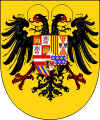
This is the imperial Coat of arms of Charles V, Holy Roman Emperor. From the time of Otto the Great onward, the various German princes elected one of their peers as King of the Germans, after which he would be crowned as emperor by the Pope. The last emperor to be crowned by the pope was Charles V; all emperors after him were technically emperors-elect, but were universally referred to as Emperor.
-
.svg.png)
This the coat of arm of Albert of Sweden. He was the King of Sweden from 1364, and in 1384 he inherited the ducal title of Mecklenburg and united the two countries in a personal union.
-

Like Western heraldry, Japanese mons were initially held only by aristocratic families, and were gradually adapted by commoners. Japanese traditional formal attire generally displays the mon of the wearer. Commoners without mon often used that of their patron or the organization they belonged to. This the coat of arm of Gion Mamori of Japan.
-

This is the White Rose of York, a white heraldic rose, which is the symbol of the House of York. Traditionally the origins of the emblem are said to go back to Edmund of Langley in the 14th century, the first Duke of York and the founder of the House of York as a Cadet branch of the then ruling House of Plantagenet.[1] The actual symbolism behind the rose has religious connotations as it represents the Virgin Mary, who was often called the Mystical Rose of Heaven.[1][2]
- ^ a b "The White Rose of Yorkshire". YorkshireHistory.com. Retrieved 2008-03-21.
- ^
 Herbermann, Charles, ed. (1913). "Liturgical Colours". Catholic Encyclopedia. New York: Robert Appleton Company.
Herbermann, Charles, ed. (1913). "Liturgical Colours". Catholic Encyclopedia. New York: Robert Appleton Company.
Logos and trademarks
A trademark is a distinctive sign or indicator used by an individual, company or other entity to identify its products or services and to distinguish them from those of other producers. A trademark is a type of intellectual property, and typically a name, word, phrase, logo, symbol, design, image, or a combination of these elements.[24]
-

Google is a young high-tech company, and its logotype created by Ruth Kedar reminds us of the Mondrian minimalism. Kedar has emphasized the playfulness of her design, and its simplicity that conveys an illusion of non-design. According to her " The colors evoke memories of child play, but deftly stray from the color wheel strictures so as to hint to the inherent element of serendipity creeping into any search results page ... The texture and shading of each letter is done in an unobtrusive way resulting in lifting it from the page while giving it both weight and lightness.[3]
- ^ There is no proof as to who originally wrote it, but master Penman Louis Madarasz(1859-1910) was said to have told one of his students that the work was his. When the work was created Madarasz had a mail-order business and could easily have done it, and the writing style is similar to his. In the book "An Elegant Hand" by William E Henning, it states that Frank Mason Robinson, who was the bookkeeper of the firm oringinated the name Coca-Cola and specified that it be written in Spencerian script. In a 1914 court case, Robinson testified that he was "practically the originator" and that "some engraver here by the name of Frank Ridge was brought into it"
- ^ "Minority Report: The Cola clash of civilisations", by Jerome Taylor, The Independent, Thursday, 10 July 2008
- ^ Google Logo Design and History Read Kedar interview here
Rebranding
Rebranding means staying relevant as competition heats up and sales start to stagnate. In such circumstances companies often seek to breathe new life into the brand through rebranding. The idea behind it is that the assumptions made when the brand was established may no longer hold true.[25]
Signage of culture and peace
-
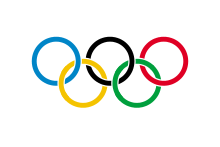
This flag of the Olympic Games that has been designed by Pierre de Coubertin reminds the viewer of the minimalism of Mondrian. According to Coubertin "This design is symbolic; it represents the five continents of the world, united by Olympism, while the six colours are those that appear on all the national flags of the world at the present time"[1]
The logo of the Socialist Party (France). The rose symbol represents; community (the flower's petals), socialism (its red color), taking care of those who are less able to compete (the fragility), the struggle (the thorns), cultural life (beauty). Historically, the red rose became the party's emblem during the nineteen-seventies. The fist symbol was a sign of resistance. Although the Mitterrand Socialists turned the fist into a graphic holding a rose.[26]
Known worldwide by its panda logo, the Switzerland-based World Wildlife Fund (WWF) participates in international efforts to protect endangered species and their habitats.[27]
Médecins Sans Frontières, or Doctors Without Borders, is best known for its humanitarian projects in war-torn regions and developing countries facing endemic disease. Their logo using a minimalist approach creates its visual impact.[28]
Information signs: ISOTYPE
In 1921, Otto Neurath, an Austrian social scientist, introduced graphic design in order to facilitate the understanding of various social and economical trends through the creative use of statistical charts. In 1924, Neurath advocated the establishment of the Museum of Economy and Society, an institution for public education and social information. In May 1925, the Museum's first graphical displays was opened to the public. The exhibition showed various complicated social and economical trends. By using charts which were to be intuitive and interesting the attempt was to make those concepts easy to grasp. This style of presentation at the time was called the Viennese method, but now it is known as ISOTYPE charts (International System of Typographic Picture Education).[29]
The Vienese method
Otto Neurath (1882–1945) was an enthusiast of sociology. After obtaining his PhD he worked on planning the war economy of the Austro-Hungarian empire. However, by 1919 he was engaged in the planning for a wholly new economic system of the chaotic and short-lived Bavarian Soviet Republic. He proposed for the abolition of money, but before this could be implemented, the republic was bloodily overthrown by Weimar's Social Democrats. Neurath escaped to Vienna, where he became an activist for the self-help squatters' movement. In the 1920s he joined the Vienna Circle of Logical Positivists, who attempted to establish a scientific foundation for philosophy; and at the same time he pioneered the graphic methods that became Isotype and were shown in the "Museum of Society and Economy". He fled Vienna after the collapse of its social democratic city government in 1934. Neurath's final years were spent in Britain, as postwar planner for the Midlands town of Bilston.[30]
As Lupton argues: Neurath suggested "two central rules for generating the vocabulary of international pictures: reduction, for determining the style of individual signs; and consistency, for giving a group of signs the appearance of a coherent system". Reduction means finding the simplest expression of an object. For instance, silouette is a basic technique for reduction. It emulates the shadow of the image without any human intervention. Thus, it is a natural cast rather than a cultural interpretation. The sign as geometric representation of reality is both a rhetorical connotation and a practical technique for many symbol designers. Martin Krampen suggested "simplified realism;" he urged designers to "start from silhouette photographs of objects...and then by subtraction...obtain silouette pictographs."[31]
Gerd Arntz (1900–1988) was born in a German family of traders and manufacturers. He was a socio-political activist in Düsseldorf, where he joined a movement that aimed to turn Germany into a radical-socialist state form. As a revolutionary artist, Arntz was connected to the Cologne-based ‘progressive artists group’ (Gruppe progressiver Künstler Köln) and depicted the life of workers and the class struggle in abstracted figures on woodcuts. Published in leftist magazines, his work was noticed by Otto Neurath who for his ‘Vienna method of visual statistics’ needed a designer of pictograms that could summarize a subject at a glance. Neurath invited the young artists to come to Vienna in 1928, and work on further developing his ISOTYPE. Arntz designed around 4000 different pictograms and abstracted illustrations for this system.[32]
Neurath's motto was ‘words divide, images unite’. Many of his designs together with those of his protégé Gerd Arntz were the forebears of pictograms we now encounter everywhere, such as the man and woman on toilet doors. As Marina Vishmidt suggests: "Neurath's pictograms owe much to the Modernist belief that reality may be modified by being codified – standardised, easy-to-grasp templates as a revolution in human affairs.[33]
Olympic pictograms
The logos and pictograms for Olympic Games change every four years and the sponsoring city develops its own logos. Pictograms first appeared at the Olympics in London in 1948. They came into wide use, since they simultaneously communicate a message to a large number of people who speak different languages. In the absence of such signs in venues such as Olympic village there would be a need for many written signs in different languages, for example for rowing such as; Roning، Κωπηλασία، Aviron, قایق رانی، and ボート競技 which not only would be costly but also may confuse the viewers. Symbols for individual sports developed by Masasa Katzoumie and Yoshiro Yamashita in Tokyo Olympics in 1964.[34]
Pictograms in Mexico Olympic Games, 1968. A group of Olympic identity program designers collaborated on the creation of these symbols, which were employed to designate the events and installations for both the sports program and the Cultural Olympiad.[35]
Inspired by the pictograms of Gerd Arntz, Otl Aicher, design director for the Munich 1972 games, in the words of Michael Bierut "developed a set of pictograms of such breathtaking elegance and clarity that they would never be topped. Aicher (1922-1991), founder of the Ulm design school and consultant to Braun and Lufthansa, was the quintessential German designer: precise, cool and logical".[36]
Olympic Games pictograms of Barcelona in 1992 were influenced by Aicher's work. However, the geometric shapes were abandoned in favour of the characteristic line of the emblem created by Josep. M. Trias and its stylized simplification of the human body in three parts.[37]
Twenty-four sport pictograms and a series of sport illustrations for the 2010 Winter Games are created by Dutch illustrator Irene Jacobs of I’m JAC Design.
Astronomical, statistical and scientific charts
-
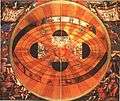
Astrnomical charts have a long history. For instance, an engraving of an ancient Egyptian diagram of the heavens from the Temple of Dendara, depicts the sky on the date of the founding of the temple in 54 BC. The above chart is an astronomical map of the sky drawn by Nicholas Copernicus in 1543 that replaced an earlier chart by Cellarius showing the Earth centred universe.[1]
-

In this graphic chart the position of two planets in relation to a viewer, and their position as they appear to a specific viewer is shown. These types of charts are used in various textbooks to describe various scientific phenomena. They are used as well by manufacturers for their manuals in order to help the buyers to become familiar with the working of a gadget.[2]
-

This is a bubble chart, which can show the relationship between three variables. These charts facilitate the understanding of the social, economical, medical, and other scientific relationships.[3]
- ^ Heavens World Treasures of the Library of Congress: Beginnings
- ^ "The role of graphics in training documents: toward an explanatory theory of how they communicate," by Winn, W., Professional Communication, IEEE Transactions on Volume 32, Issue 4, December 1989 Page(s):300 - 309, Digital Object Identifier 10.1109/47.44544
- ^ Bubble Charts
Statistics is becoming increasingly more important in modern society. Various computer software can easily transform a large set of data into charts, graphs, and statistics of various types in an attempt to provide us with succinct information to make decisions.[38]
Dynamic designs and computer animation
-

Computer animation creates the illusion of motion by viewing a succession of computer-generated still images. In the past, animation was produced by filming painted sequences on plastic or paper cels. The above animation was created from photos by Eadweard Muybridge in 1887. Computer animation can be used to produce special effects for educational purposes, such as the study of planetary motions, particle collisions, or fluid dynamics.[1]
-

Dynamic graphics are used to facilitate understanding of concepts in science, engineering, medicine, education, and business. Computer graphics facilitates the production of images that range in complexity from simple line drawings to three-dimensional reconstructions of data. The evolution of a phenomenon through time and its interactions with other elements can be shown through animation.[2]
-

In this 3-D dynamic design a house is studied from various angles. These types of animations can be very useful in the study of various objects. They can also be used to study the evolution of a process through time.:[3]
-

The art of dynamic designs is still in its infancy. With the availability of sophisticated computer graphics techniques the horizon has been expanded enormously for graphic designers.
- ^ Encarta: "Eadweard Muybridge". Archived 2009-10-31.
- ^ Encarta: "Computer Animation". Archived 2009-10-31.
- ^ The Art of 3-D: Computer Animation and Imaging, 2nd Edition, by Isaac Victor Kerlow, John Wiley & Sons; 2 Sub edition (May 11, 2000), ISBN 978-0-471-36004-9
Pioneers of modern graphics and industrial design
-
.svg.png)
In 1907, AEG (Allgemeine Elektricitäts-Gessellschaft) retained Peter Behrens, a German architect and designer, as artistic consultant. He designed the entire corporate identity (logotype, product design, publicity, etc.) and for that he is considered the first industrial designer in history. He never became an employee of AEG, but worked as an artistic consultant.[1]
-

Paul Rand an American graphic designer, is best known for his corporate logo designs. His career began with a part-time position creating stock images for a syndicate that supplied graphics to various newspapers and magazines.[2] Between his class assignments and his work, Rand was able to amass a fairly large portfolio, largely influenced by the German advertising style Sachplakat (object poster) as well as the works of Gustav Jensen.[3]
- ^ Stanford Anderson: "Peter Behrens and a New Architecture for the Twentieth Century", page 252. The MIT Press 2000.
- ^ Heller, Steven. “Thoughts on Rand.” Print, May–June 1997: 106–109. Bierut, Michael. “Tribute: Paul Rand 1914–1996.” ID, Jan–February 1997: 34. Rand, Paul. Thoughts on Design. New York: Wittenborn: 1947. Kroeger, Michael. Interview with Paul Rand. MK Graphic Design. 8 February 1995. 15 February 2006
- ^ Gallery of Paul Rand Works
Raymond Loewy was one of the best known industrial designers of the 20th century. Born in France, he spent most of his professional career in the United States. Among his many contributions were the Shell logo, the Greyhound bus, the S-1 locomotive, the Lucky Strike package, Coldspot refrigerators and the Studebaker Avanti. Loewy was first approached by the greyhound corporation to redesign its logo. The company's logo looked like a 'fat mongrel' he said. So, he created a slimmed-down version that is still used today.[39]
William Golden is one of the pioneers of American graphic design. He was born in lower Manhattan, the youngest of twelve children. His only formal schooling was at the Vocational School for Boys, where he learned photoengraving and the basics of commercial design. In conjunction with the Didot typeface, Golden developed the famous CBS Eye logo. It has been suggested that the eye was inspired by an article in Alexey Brodovitch's Portfolio about the subject of Shaker design.[40]
Placards and posters
Placard and posters existed from the ancient times. The Persian reliefs that depicted the important historical events; and the Greek axons and the Roman Albums, with their decorative designs and announcements, were quite similar to today's posters. In ancient Greece the name of athletes, and games schedules were written on columns that were slowly turning on an axis. Romans used whitewashed walls in their markets in which sellers, money lenders, and slave traders wrote their announcements and advertised for their products, and to attract the attention of customers they added attractive designs to their announcements.[41]
Ancient reliefs
-

This Persian rock relief depicts Ardashir I Coronation scene; the first king of the Sassanid Empire of Iran. Ardashir receives the ribboned diadem (cydaris), the symbol of kingship, from the spirit of Darius I of Persia of the Achaemenid dynasty.[1] Under the horse of the King Ardashir lies the last of the Parthian Kings, Artabanus. Under the horse of King Darius lies Gaumata the usurper, a Magian,. The relief of Ardashir is, therefore, the legitimization of the new Sassanian dynasty by the pre-Alexander Achaemenid dynasty. The inscription in Persian, Parthian, and Greek, reads: This is the image of the Hormizd-worshipping Majesty Ardashir, whose origin is of the gods.[2]
-

Sassanid king Shapur I of Iran in this relief at Naqsh-e Rostam, celebrats his victories over the Roman emperor Publius Licinius Valerianus. Iran, City of Marvdasht, Province of Fars. According to his records: "Just as we were established on the throne, the emperor Gordianus gathered in all of the Roman Empire an army of Goths and Germans and marched ... against us. On the edges of Assyria,... there was a great frontal battle. And Gordianus Caesar perished, and we destroyed the Roman army. And the Romans proclaimed Philip emperor. And Philip Caesar came to us for terms, and paid us 500,000 denars as ransom for his life and became tributary to us".[3]
-
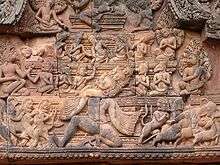
Relief at the temple Banteay Srei in Angkor, Cambodia, depicting a religious scene.[4] It is dedicated in 967 AD to the Hindu god Siva. In the middle of the scene stands the ten-headed demon king Ravana. He is shaking the mountain in its very foundations as the animals flee from his presence and as the wise men and mythological beings discuss the situation or pray.<ref>According to the legend, Shiva stopped Ravana from shaking the mountain by using his toe to press down on the mountain and to trap Ravana underneath for 1000 years. The east-facing pediment on the southern library shows Shiva seated on the summit of Mount Kailasa, his mythological abode. His consort Uma sits on his lap and clings anxiously to his torso. Other beings are also present on the slopes of the mountain, arranged in a strict hierarchy of three tiers from top to bottom. In the top tier sit bearded wise men and ascetics, in the middle tier mythological figures with the heads of animals and the bodies of humans, and in the bottom tier large animals, including a number of lions.
-

This shrine stela from the early part of the Amarna Period depicts an intimate family moment of Pharaoh Ankhenaten, his wife Nefertiti, and Princesses Meretaten, Mekeaten, and Ankhesenpaaten worshiping the Aten as a family. While Akhenaten leans forward to give Meretaten a kiss, Mekeaten plays on her mother's lap and gazes up lovingly. At the same time Ankhesenpaaten, the smallest, sits on Nefertiti's shoulder and fiddles with her earring. At the top of the composition, the sun-god, Aten, represented by a raised circle, extends his life-giving rays to the Royal Family.[5]
- ^ Ardashir takes the diadem with his right hand, and salutes Darius with his left fist and pointed index finger as a token of respect and obedience (a gesture repeated on many Sassanian rock reliefs). Both kings are on horseback and are of equal size.
- ^ Th. Noldeke, Geschichle der Perser and Araber zur Zell der Sasaniden, aus der arabischen Chronik des Tabari, 1879, See also R. Ker Porter, Travels (1821-1822), i. 548 foil.; Flandin et Coate, Voyage en Perse, iv. 182; F. Stolze and J. C. Andreas, Persepolis, pl. 116; Marcel Dieulafoy, L'Art antique de la Perse, 1884-1889, V. pl. 14
- ^ Mahmud Tavoosi and R.N. Frye, "An Inscribed Capital [sic 1.] dating from the time of Shapur I", Bulletin of the Asia Institute, N.S., 3, 1989, pp. 25-38; Ph. Gignoux, "D'Abnûn aà Mâhân", Stud. Ir. 20, 1991, pp. 9-17. Idem, "Noms propres sassanides en Moyen-Perse epigraphique" (Personennamenbuch II/2), Vienna, 1986. , pp. 9-17; V.A. Livshits and A.B. Nikitin, "Some Notes on the Inscription from Nasárâbâd," Bulletin of the Asia Institute, N.S. , 5 (1992), pp. 41-44; D. N. MacKenzie,"Shapur's shooting," BSOAS, XLI, 1978, pp. 499-501. Idem, "The fire altar of happy *Frayosh," Bulletin of the Asia Institute, N.S., 7, pp. 105-109;P. O. Skjaervø, see H. Humbach and P. O. Skjaervø. P. O. Skjaervø, "L'inscription d'Abnûn et l'imparfait en moyen-perse," Studia Iranica 21, 1992, pp. 153-60, W. Sundermann, "Shapur's Coronation: The Evidence of the Cologne Mani Codex Reconsidered and Compared with Other Texts", Bulletin of the Asia Institute, N.S., 4, 1990, pp. 295-99. Idem, "The Date of the Barm-e Delak Inscription," BAI n.s., 7, 1993, pp. 203-205. .
- ^ Banteay Srei, is unique among the great temples of Angkor in that it was built not by a monarch, but by a courtier and scholar named Yajnavaraha ("the sacrificial boar"), who served as an advisor and guru to the Cambodian King.
- ^ Arnold, Dorothea, The Royal Women of Amarna: Images of Beauty from Ancient Egypt, ISBN 978-0-87099-818-8
Emergence of the print and design industry
Around 1450, Johann Gutenberg's printing press made books widely available in Europe. The book design of Aldus Manutius developed the book structure which would become the foundation of western publication design. With the development of the lithographic process, invented by a Czech named Alois Senefelder in 1798 in Austria, the creation of posters become feasible. Although handmade posters existed before, they were mainly used for government announcements. William Caxton, who in 1477 started a printing company in England, produced the first printed poster.[42] In 1870, the advertising poster emerged.[43][44]
-

Aristotle printed by Aldus Manutius, 1495-98 (Libreria antiquaria Pregliasco, Turin)
-

A page from Francesco Colonna's Hypnerotomachia Poliphili, printed by Aldus Manutius
-

The printer's device of William Caxton, 1478.
-

A woodcut from William Caxton's second edition of the Canterbury Tales printed in 1483.
Engraving
Engraving is the practice of incising a design onto a hard, usually flat surface, by cutting grooves into it. The process was developed in Germany in the 1430s from the engraving used by goldsmiths to decorate metalwork. Engravers use a hardened steel tool called a burin to cut the design into the surface, most traditionally a copper plate.[45] Gravers come in a variety of shapes and sizes that yield different line types.
-

Theodor de Bry (1528 – 1598) was an engraver, goldsmith and editor. An engraving portrait of Theodorus de Bry, by himself and confirming his origins from Liège, in Latin "Leodiensis", between brackets: (a city at that time belonging neither to Flanders or Wallonia, or even to Belgium).
-

Albrecht Dürer, St Jerome in his study. Albrecht Dürer was a German painter and printmaker. (1514)
-
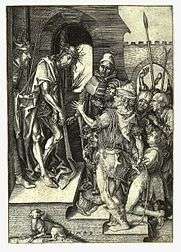
Ecce Homo, Engraving, 15th century, by Martin Schongauer(c. 1448 – 1491). He was a German engraver and painter, and was the most important German printmaker before Albrecht Dürer.
-
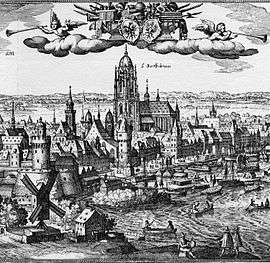
Matthäus Merian, View of Frankfurt, between 1612 and 1619. Merian was a notable Swiss engraver.
Etching
Etching is the process of using strong acid or mordant to cut into the unprotected parts of a metal surface to create a design in intaglio in the metal. This technique is believed to have been invented by Daniel Hopfer (c. 1470-1536) of Augsburg, Germany, who decorated armour in this way, and applied the method to printmaking. Etching soon came to challenge engraving as the most popular printmaking medium. Its great advantage was that, unlike engraving which requires special skill in metalworking, etching is relatively easy to learn for an artist trained in drawing.
-
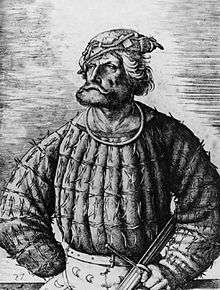
Court jester of Emperor Maximilian I. Etching by Daniel Hopfer, (1493).
-
.jpg)
Gardener with basket, c. 1612, Etching by Jacques Bellange . He was an artist and printmaker from Lorraine, now in France.(c. 1575 - 1616).
-
.jpg)
Pornocrates by Félicien Rops. He was a Belgian artist, and printmaker in etching and aquatint, 1896.
-
_British_Museum.jpg)
William Blake's Ancient of Days, etching/watercolour, (1794).
Modern graphic design
Perhaps it would be possible to consider William Morris the father of modern graphics. In the second half of the 19th century his Kelmscott Press produced many graphic designs, and created a collectors market for this kind of art. In Oxford he associated with artists like Burne-Jones, and Dante Gabriel Rossetti. Together they formed the Pre-Raphaelites group, and their ideas influenced the modern graphic design considerably.[46][47]
-
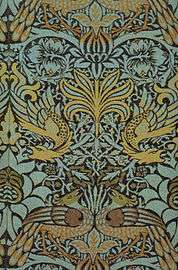
This fabric design called Peacock and Dragon, which is the work of William Morris (1878) is an example of decorative graphic design. Such designs was revived during the 1960s with the emergence of the hippie movement.
-
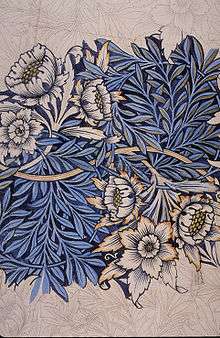
This Morris Tulip and Willow design (1873) is another example of decorative graphics. By using a diagonal blue, with only some suggestion of orange the artist tries to create a harmonious color scheme that could be used effectively in the design of a poster or other graphic design media.
-
.jpg)
This is the first page of The Nature of Gothic by John Ruskin which was published by Kelmscott Press of William Morris. The decorative design was the revival of the Gothic style in graphic design.
-
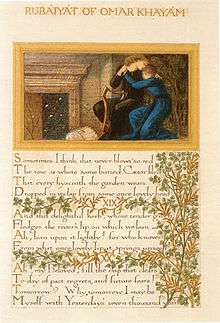
This book of poetry, called Rubaiyat, by the famous Persian poet Omar Khayyam, is an example of early modern graphic design cooperation. The graphic composition of calligraphy and its decorative design are by Morris and the painting is by Burne-Jones.
Posters Post-World War II
After the Second World War, with the emergence new color printing technology and particularly appearance of computers the art of posters underwent a new revolutionary phase. People can create color poster on their laptop computers and create color prints at a very low cost. Unfortunately, the high cost sophisticated printing processes can only be afforded mostly by the government entities and large corporations. With the emergence of internet the role of posters in conveying information has greatly diminished. However, some artist still use the chromolithography in order to create works of arts in the form of print. In this regard the difference between painting and print has been narrowed considerably.
Psychedelic design
The word "psychedelic" means "mind manifesting". Psychedelic art is art inspired by the psychedelic experience induced by drugs, and refers above all to the art movement of the 1960s counterculture. Psychedelic visual arts were a counterpart to psychedelic rock music. Concert posters, album covers, lightshows, murals, comic books, underground newspapers and more reflected revolutionary political, social and spiritual sentiments inspired by psychedelic states of consciousness.[48]
Although San Francisco remained the hub of psychedelic art into the early 1970s, the style also developed internationally. Pink Floyd worked extensively with London-based designers, Hipgnosis to create graphics to support the concepts in their albums like this cover of Soundtrack from the Film 'More'. Life magazine's cover and lead article for the September 1, 1967 issue at the height of the Summer of Love focused on the explosion of psychedelic art on posters and the artists as leaders in the hippie counterculture community.
Yellow Submarine was a milestone in graphic design, inspired by the new trends in art, it sits alongside the dazzling Pop Art styles of Andy Warhol, Martin Sharp, Alan Aldridge and Peter Blake. Heinz Edelman was hired by TVC as the art director for this film. Before making Yellow Submarine, TVC had produced The Beatles, a 39 episode TV series "produced" by Al Brodax and King Features. Despite the critical acclaim of his design work for the film, Edelman never worked on another animated feature.[49]
Peter Max's art work was a part of the psychedelic movement in graphic design. His work was much imitated in commercial illustration in the late 1960s and early 1970s. In 1970, many of Max's products and posters were featured in the exhibition "The World of Peter Max" which opened at the M.H. de Young Memorial Museum in San Francisco. He appeared on the cover of Life magazine with an eight-page feature article as well as The Tonight Show Starring Johnny Carson and The Ed Sullivan Show.[49]
Poster design in Japan
The distinctive aesthetics of Japanese graphic design have been admired over many decades, winning awards at prestigious international venues.[50]
The works of Japanese graphic designers are noted for their resourcefulness, powerful visual expression and extraordinary technical quality of print.[51]
The distinctive artistic language and typographic sophistication show particularly in Japanese poster-design. The Japanese poster is a compelling pictorial medium and an original work of art, reflecting in full the designer's creative talent.
Chinese cultural revolution
The poster "Revolution promotes production", created by He Shuxui, celebrates traditional ceramic painting techniques. A plaque in the background commemorates a group of ceramic workers as an outstanding productive unit, 1974.[52]
A worker named Wang Qing Cang created the poster "The three countries of Indo Zhina (Lao, Cambodia, Vietnam) will win!". On the upper left side, it says "Enemies are getting sicker and sicker every day, and we are getting better and better every day." (The U.S. supported Indo Zhina (Indochina) governments while China supported their communist guerilla forces.) October 1964.[53]
The poster "Mao Ze Dong at Jing Gang Mountain" depicts a young Mao Ze Dong sitting against a background of Mount Jing Gang. Jing Gang Shan (Jing Gang Mountain) symbolizes the Mao Ze Dong leadership and his vision to unite the oppressed masses to fight against and fight against the ruling class. Created by Liu Chun Hua and Wang Hui, October 1969.[54]
The poster, "Time is Money", features the famous Canadian doctor Norman Bethune (Dr. Bai Qiuen in Chinese), racing to rescue another patient. Bethune became an early proponent of universal health care, the success of which he observed during a visit to the Soviet Union. As a doctor in Montreal, Bethune frequently sought out the poor and gave them free medical care. As a thoracic surgeon, he traveled to Spain (1936–1937) and to China (1938–1939) to perform battlefield surgical operations on war casualties. Created by Zhang Xin Gua. Hebei People's Publishing House.[55]
Culture and politics
-

This magazine cover reproduced from an original poster by Guity Novin, depicts four famous Iranian writers of the 20th century (Jalal Al-e-Ahmad, Samad Behrangi, Ali-Akbar Dehkhoda, and Sadeq Hedayat). In order to create this color scheme the artist uses only two colors (orange and green) over a yellow background. By using a circular arrangement of faces she tries to achieve a balanced composition.[1][2] (1971).
- ^ "A Heritage from Ancient Persia" A critique of Guity Novin's exhibition Lost Serenade at the Brock Street Gallery by Don McCallum, The Whig-Standard, Vol.2, No.51 Kingston, Ontario, October 3, 1981.
- ^ "Artistic Underground Surfaces" on Brock Street, by Frank Berry, The Queen's Journal, October 9, 1981. "Circles of Time, A Conversation with Guity Novin", by S. Motazedi, Shahrvand, Toronto, Vol.10, No 532, November 2000, p. 30.
Richard Avedon was an American photographer. Avedon capitalized on his early success in fashion photography and expanded into the realm of fine art. This is a solarised poster portraits of the Beatles, originally produced for 9 January 1967 edition of the American magazine Look.
The Barack Obama "hope" poster is an iconic image of Barack Obama designed by artist Shepard Fairey. The image became one of the most widely recognized symbols of Obama's campaign message, spawning many variations and imitations, including some commissioned by the Obama campaign. In January 2009, after Obama had won the election, Fairey's mixed-media stenciled portrait version of the image was acquired by the Smithsonian Institution for its National Portrait Gallery.
-

This political poster by Tiocfaidh Ár Lá about Ulster.
-

Andrew Pavlovsky poster of Poet MAYAKOVSKIY (2003). This poster is a graphic illustration of a true interest to Constructivism in Russia today. This Art Movement (Constructivism) was almost always in demand in Russia and it can become one of principal trends now. Some of the contemporary Russian artists and art historians have already suggested the new term - Additive Constructivism. It emphasizes the return to modernism, which starts to significantly push out the postmodern art practices. It's not a postmodern performance. The Constructivist color solution proves that so it is.
do
Computer aided graphic design in posters
With the arrival of computer aided graphic design an assortment of novel effects, digital techniques, and innovative styles have been emerged in poster designs. With software such as Adobe Photoshop, Corel and Windows' Paint program, image editing has become very cheap, and artists can experiment easily with a variety of color schemes, filters and special effects. For instance, utilizing various filters of Photoshop, many artists have created "vectored" designs in posters where a photographic image is solarized, sharpened, rendered into watercolor or stained glass effects or converted into bare lines with block colors. Other designs created soft or blurry styles, ripple or cascade effects and other special filters.
Advertising
Graphic design is used in advertising to announce a persuasive message by an identified sponsor; or a promotion by a firm of its products to its existing and potential customers. Egyptians used papyrus to make sales messages and wall posters. Commercial messages and political campaign displays have been found in the ruins of Pompeii and ancient Arabia. Lost and found advertising on papyrus was common in Ancient Greece and Ancient Rome. Wall or rock painting for commercial advertising is another manifestation of an ancient advertising form, which is present to this day in many parts of Asia, Africa, and South America.[56]
Advertising in the 19th century
-

This advertising flier from 1806 is for a traditional medicine called Kinseitan. Display in the Edo Tokyo Museum.
-
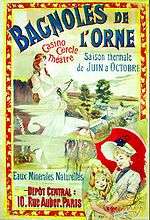
This is a 19th-century advertising poster for the hydrotherapic baths of Bagnoles de l'Orne (France).
-

This is a playbill for Perham's Opera Vocalists, 1856.
-
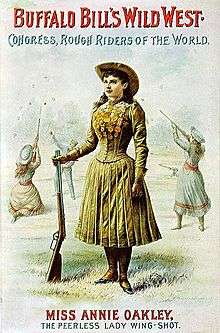
This poster from the second half of the 1880s advertises for Buffalo Bill's Wild West show, advertising "Miss Annie Oakley, the peerless lady wing-shot".
Advertising in the early 20th century
-

This is a German poster by Fritz Rehm for Laferme Cigarettes (published 1896-1900)
-

Circus poster, 1899. "Forepaugh & Sells Brothers Shows Combined. The world famed Hanlon Troupe in the most astonishing mid-air achievements ever accomplished."
-

"Drink Coca-Cola 5¢", an 1890s advertising poster showing a woman in fancy clothes (partially vaguely influenced by 16th- and 17th-century styles) drinking Coke.
German Plakatstil, "Poster style"
In the early 20th century, Germany became the cradle of many of the avant-garde art movements particularly for posters. This created the "Plakatstil" or "Poster style" movement. This movement became very influential and had a considerable impact on the graphic design for posters. Posters in this style would feature few but strong colours, a sharp, non-cluttered, minimal composition and bold, clear types.[57]
Ludwig Hohlwein
Ludwig Hohlwein was born in Germany in 1874. He was trained and practiced as an architect until 1906 when he switched to poster design. Hohlwein's adaptations of photographic images was based on a deep and intuitive understanding of graphical principles. His creative use of color and architectural compositions dispels any suggestion that he uses photos as a substitute for creative design.
for Riquet Pralinen Tea c. 1920-1926. Hohlwein was born in the Rhine-Main region of Germany, though he and his work are associated with Munich and Bavaria in southern Germany. There were two schools of Gebrauchsgrafik in Germany at the time, North and South. Hohlwein's high tonal contrasts and a network of interlocking shapes made his work instantly recognizable.
Poster historian Alain Weill comments that "Hohlwein was the most prolific and brilliant German posterist of the 20th century... Beginning with his first efforts, Hohlwein found his style with disconcerting facility. It would vary little for the next forty years. The drawing was perfect from the start, nothing seemed alien to him, and in any case, nothing posed a problem for him. His figures are full of touches of color and a play of light and shade that brings them out of their background and gives them substance"[58]
Lucian Bernhard
-

With nothing to lose, Lucian Bernhard entered a poster contest for the Priester Match Company. The judges, found this poster bizarre, and ignored it. However Ernst Growald, sales manager for Berlin's leading proto-advertising agency and poster printer, saw the discarded poster and exclaimed: "This is my first prize. This is genius!" Bernhard had won both the contest and a long-term benefactor.[1]
-

Born near Stuttgart as Emil Kahn, he changed his name to Lucian Bernhard and left home for Berlin at the age of 18 in 1901. He became the protege of Edmund Edel, an established artist, who brought him into contact with the printing company and poster publisher Hollerbaum & Schmidt. His first poster, for a match company, became an immediate success. In 1903, he opened his own studio in the center of Berlin. He left Berlin in 1922, and set up a studio in New York City.[2]
-

In 1910 the Berthold Foundry brought out a new type face in "block" letters based on Bernhard's poster lettering, which displayed a remarkable anticipation of the "Sans Serif" lettering of the 1920s. The Flinsch Type Foundry followed with the production of Bernrnhard "Antiqua", "Kursiv", "Fraktur", and half a dozen others.
- ^ PM magazine March 1936
- ^ [1] The American Institute of Graphic Arts
Over the course of his career, which lasted well into the 1950s, Lucian Bernhard became a prolific designer not only of innovative posters but of trademarks, packaging, type, textiles, furniture, and interior design.
Advertising in the 1920-30 era
-
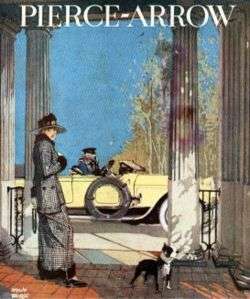
Pierce-Arrow auto ad, from advertisement in Life magazine, 1919
-

The London Underground Electric Railway Company Ltd published this poster in 1924.
-
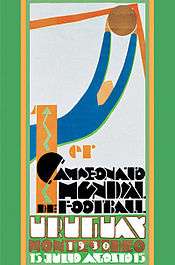
This is an official soccer poster for World Cup in Uruguay, 1930.
1972 Olympics and Otl Aicher posters
The internationally recognized artist Otl Aicher was a graphic designer, urban planner, photographer, and the mastermind behind the imagery for the 1972 Munich Olympics and the Rotis typeface. Growing as a child in Nazi Germany, Aicher, along with his friends Hans and Sophie Scholl, organized the anti-Nazi political organization Die Weisse Rose (the White Rose). In 1943, the Scholls and Aicher were arrested by the Nazi party. While Aicher was released, the Scholls went to trial where they were found guilty of treason and executed. After the war Aicher went on to help rebuild his ravaged city of Ulm and to found the influential international school of design, Hochschule für Gestaltung (HfG).[59]
In Munich's original bid for 1972 Olympic one of the main promises was to create a synthesis between sport and art. Otl Aicher was appointed as the head of the committee's visual design group, and his mandate was to deploy art in a relatively new role of promoting this global public event. From the start, posters were high on the agenda of the organizing committee, and ideas were discussed as early as September 1967 to publish a series of art posters that would ‘relate artistic activity to the Olympic Games and engage the best artists to collaborate’, and also to commission an internationally known artist for the official poster.[60]
Otl Aicher created the official posters for the 1972 Olympic Games in Munich. As he pointed out in his essay "Entwurf der Moderne"[61] (Designing the Modern Era), the German word entwerfen, meaning "to draft "or "design", also contains the verb werfen, meaning "to throw". But where? To whom? What? And with what intention? As Benjamin Secher writes: "He devised an invigorating, almost Day-glo palette for the Olympics that was utterly free of red and black - banned for their association with the German flag. Athletes depicted in the official posters for each sport had their uniforms stripped of any national identifier, leaving the emphasis firmly on individual effort. Even the logo for the Games, a graphic of a radiant sun, hammered home the message of universality and, above all, optimism."[62]
Aicher developed a comprehensive system to articulate the games' character across a wide range of materials, from signage to printed pieces and even staff uniforms. As the introduction to his exhibition at San Francisco Museum of Modern Art states: "His works including official posters and sporting event tickets, demonstrate the design tools Aicher used to join individual elements to the collective: structural grids, a bold and animating color palette, and ingenious pictograms. Aicher's orderly and pleasant design nimbly carried the weight of modern German history as it repositioned the nation's hospitality on the world stage".
This is a poster of 1972 Olympics Yachting in Germany designed by Otl Aicher. Using a bright color scheme, borrowed from 60s pop art and psychedelic art, and combining it with German modernism Aicher creates this visual graphic program.
Current advertising
Nike's My Butt is Big poster appears to covey a bold and honest statement. The only part of a body in the picture is a butt. The text of a poem on the right repeats the curved form of the woman's bottom which is repeated again with some vividly colored splosh of red and purple dots in the background. The background is white, which contrasts with the darker skin of the model. The statement, "My butt is big" is red and larger than the rest of the poem. Image:Courvoisier Cognac.jpg | This is a modern advertisement poster for Courvoisier Cognac. A balanced composition of the hands, feet, and face of the figure on a black background appear to convey the message of this poster.
This is a look alike poster advertisement for Wendy's "where's the Beef?" campaign. In the TV version of this ad, Clara Peller, a gray-haired actress, stared at an unimpressive looking hamburger and asked, "Where's the beef?" This simple message was so sharp that by asking the same question about his rival's program Vice President Walter Mondale effectively neutralized Colorado Senator Gary Hart's momentum in the 1984 presidential campaign.
This is a perfume advertisement for Chanel No 5. The combination of the female figure with the number 5, together with the striking color of dress have resulted in creation of its visual graphic impact.
Comics and graphic novels
A comic refers to a magazine or book of narrative artwork and, virtually always, dialog and descriptive prose. Despite the term, the subject matter in comic is not necessarily humorous; in fact, it is often serious and action-oriented. Due to the fact that graphic design constitutes the main foundation of comics it plays a crucial role in conveying various narratives through its compositional devices, line drawings and colouring scheme.[63]
Conventional comics and pop art
Superman, from the cover art of Superman, issue 204 (April 2004). Art by Jim Lee and Scott Williams. Superman is widely considered to be an American cultural icon.[64][65][66][67] Created by American writer Jerry Siegel and Canadian-born artist Joe Shuster in 1932. The character first appeared in Action Comics in 1938. The character's appearance is distinctive and iconic: a red, blue and yellow costume, complete with cape and with a stylized "S" shield on his chest.[68][69][70]
Shang-Chi was created by writer Steve Englehart and artist Jim Starlin. He has no special superpowers, but he exhibits extraordinary skills in the martial arts. 1972
This is Steranko's Contessa Valentina Allegra di Fontaine, from Strange Tales, (Volume 168, May 1968). Lichtenstein's Drowning Girl, and its word balloon appears to have been inspired by a comic similar to this work.
Selecting the old-fashioned comic strip as subject matter, Roy Lichtenstein used the splash page of a romance story lettered by Ira Schnapp in Secret Hearts, (volume 83, November 1962), and slightly reworked the art and dialogue by re-lettering Schnapp's original word balloon. This precise composition, titled Drowning Girl (1963) is now part of the permanent collection of the Museum of Modern Art, New York.[71]
Modern comics and graphic novels
Cover of Wanted a graphic novel by Mark Millar, J. G. Jones, Paul Mounts.
The cover of Too Cool to be Forgotten, a comics novel by Alex Robinson. Robinson's draftsmanship balances graphic panels with realism.
Poster for Persepolis (2000), L'Association French edition by Marjane Satrapi an Iranian graphic novelist. Persepolis was adapted into an animated film of the same name which debuted at the Cannes Film Festival in May 2007 and shared a Special Jury Prize.
Cover of Batman: The Killing Joke (1988). Art by Brian Bolland.
Web sites
The aim of graphic design is to make a web site understandable, memorable and attractive to the end user as well to present its content in a user friendly fashion[72][73] . The web dates back to the early 1980s at CERN, a European high energy physics research facility. Tim Berners-Lee[74] who did the initial development stage was interested in the ability to link academic papers electronically and to utilize the internet in order to correspond with people in other laboratories around the world. He is credited with the construction of the first website in August 1991.[75]
Modern life
Today graphic design has penetrated into all aspects of modern life. In particular modern architecture has been influenced by graphics.[76]
-

Robert Smithson's monumental graphic art earthwork Spiral Jetty (1970) is located on the Great Salt Lake in Utah. Using black basalt rocks and earth from the site, the artist created an artistic composition in the translucent red water with a graphic design 1,500 feet long and 15 feet wide.
-

In the architectural design of Steigenberger Hotel in El Gouna Egypt, the minimalist design with 3-D geometric composition, and monochromatic coloring scheme provides graphical compositions from various angles
See also
References
- ↑ A History of Graphic Design
- ↑ Chauvet, Jean-Marie; Eliette Brunel Deschamps, Christian Hillaire (1996). Dawn of Art: The Chauvet Cave. Paul G. Bahn (Foreword), Jean Clottes (Epilogue). New York: Harry N. Abrams. ISBN 0-8109-3232-6
- ↑ The Cave of Lascaux, by Mario Ruspoli, Harry N. Abrams (May 1, 1987), ISBN 978-0-8109-1267-0
- ↑ "Rock Shelters of Bhimbetka". World Heritage Site. Retrieved 2007-02-15.
- ↑ Encyclopædia Britannica: Aboriginal Rock Art, Ubirr Art Site, Kakadu National Park, Australia
- ↑ Drogin, Marc, Medieval Calligraphy: Its History and Technique. New York: Dover Publications, 1980. Miner, Dorothy E. compiler, 2000 Years of Calligraphy, an Exhibition Organized [1965] by the Baltimore Museum of art, et al. New Jersey: Rowman & Littlefield, 1972.
- ↑ The Kuei t'ien lu, a book of anecdotes written in the 11th century by the historian Ou-yang Hsiu, has been cited as placing the invention of playing cards in the middle of the T'ang dynasty (618-906). However, these early references appears to refer to domino cards. See Early references to Playing Cards
- ↑ John Berry, Introduction to the Exhibition 'The World of Playing Cards' at the Guildhall Library, London, from September 1995 to March 1996
- ↑ Kathleen Wowk, Playing Cards of the World, Lutterworth Press (January 1, 1983), ISBN 978-0-7188-2408-2
- ↑ Catherine Perry Hargrave, A History of Playing Cards and a Bibliography of Cards and Gaming, Dover Publications; Unabridged edition (January 11, 2001), ISBN 978-0-486-41236-8
- ↑ John Berry, Op cit
- ↑ Henry Rene D'Allemagne, Antique Playing Cards: A Pictorial History, Dover Publications (October 24, 1996), ISBN 978-0-486-29265-6
- ↑ Tom Dawson and Judy Dawson, The Hochman Encyclopedia of American Playing Cards, U.S. Games Systems (December 2000), ISBN 978-1-57281-299-4
- ↑ Playing Cards
- ↑ W. Eugene Kleinbauer, Modern Perspectives in Western Art History: An Anthology of Twentieth-century Writings on the Visual Arts, University of Toronto Press, 1989, ISBN 978-0-8020-6708-1. Strzygowski and His Theory of Early Christian Art, by Allan Marquand, Cambridge University Press and Harvard Divinity School.
- ↑ Piet Modrian, Colour, Structure and Symbolism: An Essay, by LOCHER, HANS CH-3006 Bern, Switzerland, Verlag Gachnang & Springer, Switzerland. 1994. 3906127443, Piet Mondrian, life and work, by Michel Seuphor, Harry N. Abrams (1955), ASIN: B0007EHNVI. Complete Mondrian, by Marty Bax, Lund Humphries Publishers (January 2002), ISBN 978-0-85331-803-3. Mondrian, The Transatlantic Paintings, Harry Cooper and Ron Spronk, ISBN 978-0-300-08928-8. Piet Mondrian: 1872-1944, by Yve-Alain Bois, Angelica Zander Rudenstine, Joop Joosten, Hans Janssen, Bulfinch Press; 1st edition (May 1995), ISBN 978-0-8212-2164-8
- ↑ Larousse
- ↑ "rebus definition - Dictionary - MSN Encarta". Archived from the original on 2009-11-01.
- ↑ Fox-Davies, A Complete Guide to Heraldry, (Thomas Nelson, 1925).
- ↑ Iain Moncreiffe of that Ilk & Pottinger, Simple Heraldry (Thomas Nelson, 1953).
- ↑ Appendix I. koro-.
- ↑ John Brooke-Little. An Heraldic Alphabet. (Macdonald, London: 1973),2.
- ↑ Encarta: "Heraldry". Archived 2009-10-31.
- ↑ The Random House Unabridged Dictionary, Random House, Inc. 2006.
- ↑ Kunal Gaurav, Rebranding: Concepts, Cases And Applications, Icfai University Press, (28 August-2008), ISBN 978-81-314-1496-5
- ↑ Looking Closer 5: Critical Writings on Graphic Design, by Michael Bierut, William Drenttel, Steven Heller, published by Allworth Communications, Inc., 2007, ISBN 978-1-58115-471-9
- ↑ see : Charity Navigator. "World Wildlife Fund." McKinney, Michael L. and Robert M. Schoch. Environmental Science: Systems and Solutions, Third ed. "Environmental Organizations." Jones and Bartlett Publishers. Also available online at . Parnes, Robin Brett. "How the World Wildlife Fund Works." How Stuff Works. WWF-The Conservation Organization. "A History of WWF: The Sixties." WWF.
- ↑ Bortolotti, D (2004). Hope in Hell: Inside the World of Doctors Without Borders. Firefly Books. ISBN 1-55297-865-6.
- ↑ Stroom Den Haag
- ↑ Nader Vossoughian, Otto Neurath: The Language of the Global Polis, NAi Publishers (July 1, 2008) ISBN 978-90-5662-350-0
- ↑ Ellen Lupton, Thinking with Type: A Critical Guide for Designers, Writers, Editors, & Students (Design Briefs), Princeton Architectural Press; 1 edition (September 9, 2004), ISBN 978-1-56898-448-3
- ↑ Gerd Arntz (1900-1988)
- ↑ Marina Vishmidt The Dutch Are Weeping in Four Universal Pictorial Languages At Least
- ↑ Michael Bierut, The Graphic Design Olympics
- ↑ Official Report 1968, Vol. 2, page 307, 1969, Organizing Committee of the Games of the XIX Olympiad, MEXICO 68
- ↑ Michael Bierut op cit.; See also: Olympic Games Museum
- ↑ Official Report 1992, Vol. III, page 326, 1992, COOB'92, S.A., Plaça de la Font Màgica, s/n, 08038 Barcelona
- ↑ Charlie Pabst, Statistics: Part 2, How To Properly Use Statistic Charts In Life And Business
- ↑ Setright, L.J.K., "Loewy: When styling became industrial design", in Northey, Tom, ed. World of Automobiles (London: Orbis, 1974), Volume 11
- ↑ Golden, Cipe Pineles, Kurt Weihs, and Robert Strunsky, eds. The visual craft of William Golden. New York: George Braziller, Inc., 1962. Remington, R. Roger, and Barbara J. Hodik. Nine Pioneers in American Graphic Design. Cambridge, Massachusetts: Massachusetts Institute of Technology Press, 1989. ISBN 0-262-68076-9.
- ↑ Larousse
- ↑ Encarta: "William Caxton". Archived 2009-10-31.
- ↑ In the 19th and 20th centuries artists like Jules Chéret, Daumier, Manet, Picasso, Ben Shahn, Norman Rockwell, Alexandre Steinlen, Alphonse Mucha, and Henri de Toulouse-Lautrec made compelling posters advertising products entertainments and restaurants. Matt Morgan's circus advertisements (c. 1890) started the American poster, and this was followed by Edward Penfield, Will H. Bradley, Maxfield Parrish, Howard Chandler Christie, James Montgomery Flagg, Charles Dana Gibson, and Harrison Fisher.
- ↑ M. Rickards, The Rise and Fall of the Poster (1971); J. Barnicoat, A Concise History of Posters: 1870–1970 (1972); D. Ades, The Twentieth Century Poster (1984); J. Barnicoat, Posters: A Concise History (1985).
- ↑ "Abraham Bosse". Bibliothèque nationale de France. 1645. Retrieved 2008-07-15.
- ↑ Encarta "William Morris. Archived 2009-10-31.
- ↑ Larousse "Morris".
- ↑ Masters, Robert E.L. and Houston, Jean Psychedelic Art New York: 1968 A Balance House book—printed by Grove Press, Inc.
- 1 2 Robert R. Hieronimus and Laura Cortner, Inside the Yellow Submarine; The Making of the Beatles' Animated Classic, kp books, February 01, 2002, ISBN 978-0-87349-360-4
- ↑ Japanese Posters – Today
- ↑ Richard S. Thornton, "Japanese Posters: The First 100 Years", Design Issues, Vol. 6, No. 1, Design in Asia and Australia (Autumn, 1989), pp. 4-14, Published by: The MIT Press
- ↑ Chinese Political Poster Revolution promotes production
- ↑ Chinese poster - The three countries of "In du Zhi Na"
- ↑ Mao Ze Dong at Jing Gang Mountain Poster
- ↑ Norman Bethune "Bai Qiu En" Poster - Time is Money
- ↑ Johnson, J. Douglas, Advertising Today, Chicago: Science Research Associates, 1978. ISBN 0-574-19355-3, Klein, Naomi (2000) No Logo. Harper-Collins, ISBN 0-00-653040-0, Kleppner, Otto, Advertising Procedure, Englewood Cliffs, N.J., Prentice-Hall, 1966. Wernick, Andrew (1991) Promotional Culture: Advertising, Ideology and Symbolic Expression (Theory, Culture & Society S.), London: Sage Publications Ltd, ISBN 0-8039-8390-5
- ↑ Lucian Bernhard - Werbung und Design im Aufbruch des 20. Jahrhunderts, Plakate, Gebrauchsgrafik, Verpackungsdesign, Buchgestaltung, Schriftentwuerfe; concept by Hubert Riedel, texts by Hubert Riedel, Rene Grohnert, Karl Bernhard; Institut fuer Auslandbeziehungen e.V. (1999), Linienstrasse 155, D-10115 Berlin, fax +49-30-282 3331
- ↑ Weill, Alain, The Poster a Worldwide Survey and History, G K Hall, 1985, ISBN 978-0-8161-8746-1
- ↑ The Olympic Feats of Otl Aicher
- ↑ 212 POURET Henri (FRA): "The Artistic Environment of the Olympic Athlete". In: OARe 1972, pp. 164-171.
- ↑ Otl Aicher, "Entwurf der Moderne", Arch+, vol. 98, 1989.
- ↑ Benjamin Secher, A winning way with symbols, Telegraph, 21 February 2007
- ↑ Scott McCloud, Understanding Comics: The Invisible Art, Harper Paperbacks (April 27, 1994), ISBN 978-0-06-097625-5. Lopes, Paul. "Sequential Tarts: Gender Intervention in American Comic Book Culture" Paper presented at the annual meeting of the American Sociological Association, Montreal Convention Center, Montreal, Quebec, Canada, August 11, 2006 . 2009-01-30
- ↑ Daniels (1998), p. 11.
- ↑ Holt, Douglas B. (2004). How Brands Become Icons: The Principles of Cultural Branding. Boston: Harvard Business School Press. p. 1. ISBN 1-57851-774-5.
- ↑ Koehler, Derek J.; Harvey Nigel. (eds.), eds. (2004). Blackwell Handbook of Judgment and Decision Making. Blackwell. p. 519. ISBN 1-4051-0746-4.
- ↑ Dinerstein, Joel (2003). Swinging the machine: Modernity, technology, and African American culture between the wars. University of Massachusetts Press. p. 81. ISBN 1-55849-383-2.
- ↑ Daniels (1998), p. 18.
- ↑ Wallace, Daniel; Singer, Bryan (2006). The Art of Superman Returns. Chronicle Books. p. 22. ISBN 0-8118-5344-6.
- ↑ "Designing Man of Steel's costume". Manila Standard. July 21, 2006. Archived from the original on 2008-09-03.
- ↑ Janis Hendrickson and Roy Lichtenstein, Roy Lichtenstein, Benedikt Taschen Verlag (June 1996), ISBN 978-3-8228-9633-4, Diane Waldman, Roy Lichtenstein, Guggenheim Museum Pubns (November 1994), ISBN 978-0-8109-6875-2, Elizabeth Brown, Dave Hickey, Roy Lichtenstein, and Chris Bruce; Roy Lichtenstein: Prints 1956-1997, Marquand Books, Inc./Museum of Art/Washington State University (October 15, 2005), ISBN 978-0-9755662-1-3, Susan Goldman Rubin, Whaam! The Art and Life of Roy Lichtenstein, Abrams Books for Young Readers; 1 edition (October 1, 2008), ISBN 978-0-8109-9492-8
- ↑ According to the web designer Armin vit; although, web sites are a different breed of design project, the same principles of graphic design apply: "How do you render information in a manner that is understandable, memorable and pleasing to the end user? ... Yet, when it comes to web design it's rare that all elements — functionality, clarity of information, and subjective beauty — come together to create a result that is widely admired, recognized or lauded in the same vein as anything resembling the likes of Saul Bass’ AT&T logo, or Susan Kare's icons for the original Mac OS". (Armin Vit Landmark Web sites, where Art Thaou?)
- ↑ WordArc
- ↑ "Berners-Lee on the read/write web". BBC News. August 9, 2005. Retrieved January 5, 2010.
- ↑ John Naughton, A Brief History of the Future: The Origins of the Internet, Phoenix; 2nd Revised edition (5 October 2000), ISBN 978-0-7538-1093-4, Jakob Nielsen, Designing Web Usability: The Practice of Simplicity, Peachpit Press (January 2000), ISBN 978-1-56205-810-4, Steve Krug, Don't Make Me Think!: A Common Sense Approach to Web Usability, New Riders; 2 edition (8 September 2005), ISBN 978-0-321-34475-5
- ↑ A History of Modern Design: Graphics and Products Since the Industrial Revolution, by David Raizman, Laurence King Publishing (February 9, 2004), ISBN 978-1-85669-348-6

